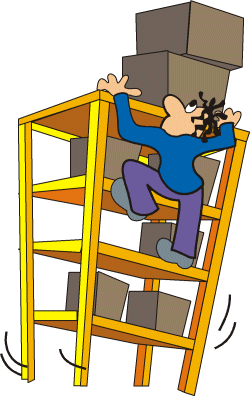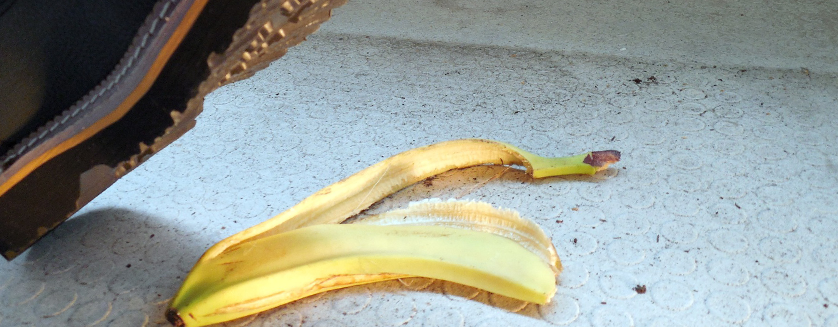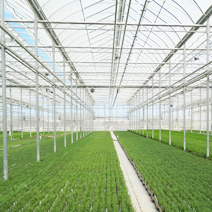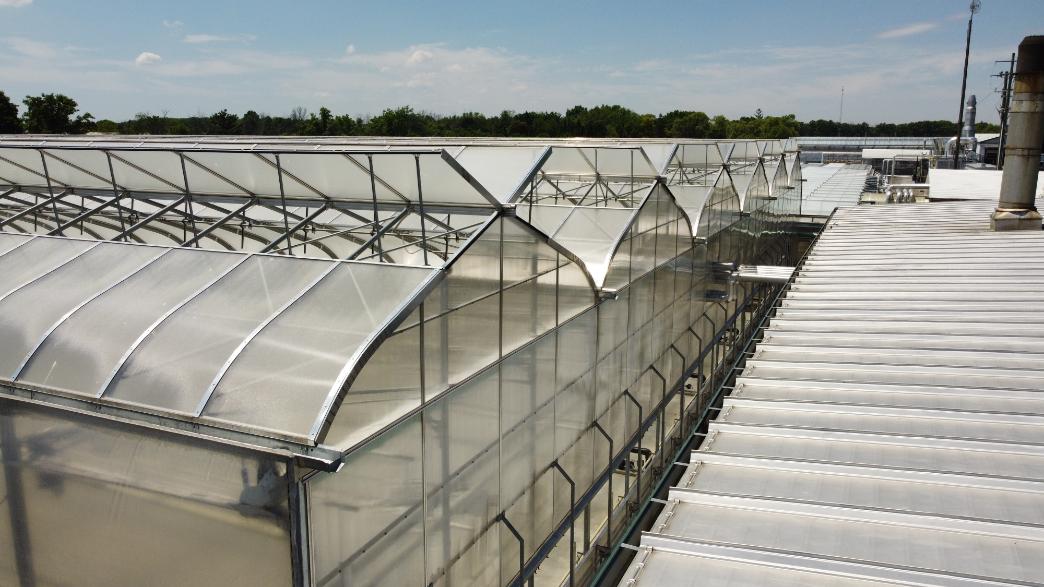Top 10 Causes of Injuries in the Greenhouse
If you are running a greenhouse growing operation you are well aware that accidents causing injuries are a very real concern. The following is a list of the top 10 causes of injuries in a greenhouse operation and ways of prevention:
1. Careless use of Ladders
 You can find someone using a ladder virtually every work day in a greenhouse environment. Ladders are a necessity when checking on vent components, shading issues and glass repair. Climbing any sort of ladder is potentially dangerous but not if done properly and with precaution. Extension ladders can be heavy; sometimes it is necessary to use 2 people to avoid back strain. Make sure that the feet of the ladder are on a firm level surface. The rule of thumb is that the horizontal distance of the ladder feet is to be ¼ of the working length of the ladder. If the working length is 10 feet or more a harness or safety belt is required with the lanyard tied to the structure. And finally, use common sense when on a ladder; don’t lift anything that is too heavy while working on the ladder and don’t stretch your body beyond what is comfortable for working.
You can find someone using a ladder virtually every work day in a greenhouse environment. Ladders are a necessity when checking on vent components, shading issues and glass repair. Climbing any sort of ladder is potentially dangerous but not if done properly and with precaution. Extension ladders can be heavy; sometimes it is necessary to use 2 people to avoid back strain. Make sure that the feet of the ladder are on a firm level surface. The rule of thumb is that the horizontal distance of the ladder feet is to be ¼ of the working length of the ladder. If the working length is 10 feet or more a harness or safety belt is required with the lanyard tied to the structure. And finally, use common sense when on a ladder; don’t lift anything that is too heavy while working on the ladder and don’t stretch your body beyond what is comfortable for working.
2. Operating greenhouse machinery
It is reported that most injuries from agricultural machinery can be attributed to human error. In many cases a shortcut was taken or the operator was not paying total attention to the operation. Injuries occurring on greenhouse machinery can be crippling or sometimes even fatal, it is important that you have a diligent and safety minded employee operating the machinery that is alert to possible hazards and takes precautions to avoid injury. Proper training and safety manuals should be implemented on each piece of machinery in or around the greenhouse combined with reminders from supervisors to aid in avoiding accidents and injuries on this equipment.
 3. Greenhouse machinery in need of repairs
3. Greenhouse machinery in need of repairs
All greenhouse equipment and machinery needs to have proper lockout procedures. Train your employees to identify problems for future inspection. Tagging equipment that there is a concern with will improve employee safety and will help you get the most out of your equipment by identifying issues quickly, problems can be resolved before they cost you or your employees.
4. Improper handling of hazardous material
“Hazardous Material” is generally abundant in a greenhouse environment; pesticides, herbicides, acid and Hydrogen Peroxide just to name a few. Each chemical demands respect and safe handling and application practices. Each and every employee that will have to handle hazardous material should have WHMIS training as well as a pesticide licence. WHMIS training will give the employee the knowledge needed in identifying the hazardous symbols on chemical containers such as “Corrosive Material”, “Poisonous Material”, or “Flammable Material”. Having an employee that is directly involved with hazardous material obtain a pesticide licence trains one in the mixing and application of these chemicals. When dealing with harsh chemicals, an educated employee is a safe employee.
5. Slips and falls

Slipping on a wet surface or tripping over objects on a walkway can have serious consequences and makes up a substantial number of greenhouse injuries. The preventative measure is quite simple:
Keep all aisles and walkways free of clutter, clean up oil spills and other slippery products immediately and have a regular cleaning schedule where the walkways and aisles are swept on a regular basis. The key is to be aware of tripping hazards and to train your staff to be alert on the job and to develop that awareness of what could constitute a slip or trip hazard.
6. Heat stress on employees
The summer months can produce both high temperatures and high humidity levels which can be very dangerous for greenhouse employees. When the high heat and humidity are combined with other physical stresses such as hard physical work and fatigue, the results can be heat related illness or even death. Water is crucial to getting the body to adjust to high temperatures; the rate of water intake must equal the rate of water loss by perspiration to regulate normal body temperature. Supervisors must remind employees to drink plenty of water during the warmer months and have a supply of fresh drinkable water on hand. Whenever possible it would be advantageous to send employees home early during the hottest periods, this will avoid the possibility of heat stress altogether.
7. Poor lifting and carry techniques
 Improper lifting techniques result in a large percentage of back injuries among agricultural workers. Safe lifting and carrying practices taught to all employees will greatly diminish the chance of incurring such injuries. Over time the “safe” techniques taught will become a habit. Teach your employees to exam the object and determine if maybe they might need equipment to lift and carry the object instead of trying to do it themselves. If they are able to lift it they should: have good balance by keeping feet shoulder width apart, bend at the knees and don’t stoop, lift up by pushing up with the legs, and keep elbows and arms close to the body. While carrying the object they should carry the load close to the body and don’t twist the body, shift foot positions instead if a change of direction is required, and most important of all: watch where they are going!
Improper lifting techniques result in a large percentage of back injuries among agricultural workers. Safe lifting and carrying practices taught to all employees will greatly diminish the chance of incurring such injuries. Over time the “safe” techniques taught will become a habit. Teach your employees to exam the object and determine if maybe they might need equipment to lift and carry the object instead of trying to do it themselves. If they are able to lift it they should: have good balance by keeping feet shoulder width apart, bend at the knees and don’t stoop, lift up by pushing up with the legs, and keep elbows and arms close to the body. While carrying the object they should carry the load close to the body and don’t twist the body, shift foot positions instead if a change of direction is required, and most important of all: watch where they are going!

8. Greenhouse Fire
Heat, oxygen and fuel: they are not only essential to life but they also serve as the elements to destructive greenhouse fires. Understanding your greenhouse and how to prevent fires will best keep your employees protected. Heat is almost always the culprit to fueling fires, but heat usually has an accomplice. Degrading and overheated wires or improper wire installation can easily ignite anything combustible within range as well as exhaust pipes from open flame heaters and CO2 burners are very hazardous due to the pipes reaching extremely high temperatures when releasing unburned gases. Fuel in the greenhouse refers to anything combustible that might be stored in a structure. Greenhouse covers – especially those of polymer material – along with shade cloths, wood furniture, plastic pots, nitrogen-based fertilizers, insecticides, fungicides, oil, propane, and natural gas, cardboard and straw can all be fuel to the fire. Educate your staff on the dangers of all of these elements in the greenhouse; awareness can aid in prevention.
9. Greenhouse Construction Accidents
 Greenhouses are often expanding and building onto the sides and ends of existing greenhouses. Or when not expanding, retrofitting gutter vents, raising the roof, replacing poly, or installing glass are common reasons for on site construction. Greenhouse construction sites have a different set of safety hazards than your workers are typically concerned with. Construction areas in the greenhouse should be appropriately marked and where possible fenced or roped off from the everyday work force.
Greenhouses are often expanding and building onto the sides and ends of existing greenhouses. Or when not expanding, retrofitting gutter vents, raising the roof, replacing poly, or installing glass are common reasons for on site construction. Greenhouse construction sites have a different set of safety hazards than your workers are typically concerned with. Construction areas in the greenhouse should be appropriately marked and where possible fenced or roped off from the everyday work force.
10. Shipping and Receiving Mishaps
Everyday trucks are coming in to your greenhouse delivery supplies or picking up plants ready to ship. Forklifts are moving in and out of your warehouse shipping area, and truck drivers of varying experience and load distribution are backing into your facility to handle the materials. Every greenhouse operation should have firm procedures regarding who is allowed in loading and unloading areas, blocking off the truck wheel if a proper loading dock is not in place, and ensure that the forlklift operator always has a safety spotter in line of site.








